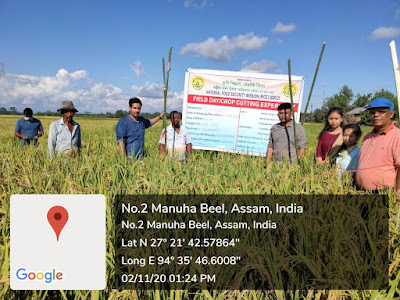As
extension personnel have publicly argued, the communication gap between extension and
farmers has widened since the extension reforms (ZREAC Kharif-ZREAC for UBZ, Proceedings,2020).
Indeed, it was government policies and programmes that worsened the chasm. In
Assam, 54% of farmers lacked access to information, while 30% received right
ADO/VLEW (NSSO,2013). Based on primary and secondary data, some policy-level
suggestions that strengthened government policies may help avert future crises.
Image: Successful demonstration of a 'Recommended Technology' by an ADO
The organisation's current challenges...
- Over 40% of field-level staff positions still need to be filled.
- As of 01.04.2020, 256 Director to ADO positions remains vacant out of 930 total. Out of 33 districts, only 28 District Agriculture Officer positions are vacant.
- Due to many vacancies, numerous ADOs and VLEWs are assigned 2-3 circles/leaks.
- The post-T&V scheme needs a clear job description for ADOs and AEAs.
- ADOs perform a variety of tasks outside their domain throughout the year.
- ADO and AEA have no scheduled official visits to meet with farmers.
- ADO/AEA does not have an official job description.
Policy recommendation:
-Increase the rate at which vacant positions are filled (Recently, the government started to fill up the vacant post. In 2023, the situation is immensely improved for human resources)
-There
is an immediate need to develop job descriptions for all cadres
that reflect
agriculture's current state.
The organisation's current challenges...
- Extension officers help government programmes targeted toward beneficiaries, and their services are limited to the beneficiaries and the programme
- Extension personnel are perplexed by the term "recommended technology."
Recommendation for Policy
-Associating
extension personnel with all other responsibilities is critical,
as agriculture
is a time-sensitive activity.
-Considering
the competitive market environment, the department
should prioritise who or how
technology will be recommended.
The
organisation's current challenges...- ATMA's performance is deficient.
- ATMA is being piloted with the help of temporary field-level extension staff.
- ATMA is still running on an ad hoc basis.
- The organisation continues to run the post-T&V system to work as the central public extension service provider.
-Evaluate the ATMA model's feasibility, which has been in experimentation since 2005.
The
organisation's current challenges...
- There is no opportunity for advanced agricultural sector building capacity and no refresher training to keep knowledge current.
- There needs to be more information available to extension personnel.
- The average age of extension personnel is more than 50 years.
- The Directorate of Horticulture was created without creating positions.
Recommendation for Policy
-Infrastructure
for the flow of information from various sources must be
set up at the DAO/SDAO
level.
-Within the Directorate of Horticulture, new jobs should be created and returned to the attached officers of the Agriculture Department.
The organisation's current challenges...
- Inadequate space for ADO offices
- Without FMCs, ADO/AEA service is affected.
- Extension services are not financially supported.
-The Office may be set up with Development Block.
-Maintain a budget to support the cost of routine extension services, which are not covered by any schemes.
(Opinions are the author’s personally
prepared based on observation and primary and secondary data)



